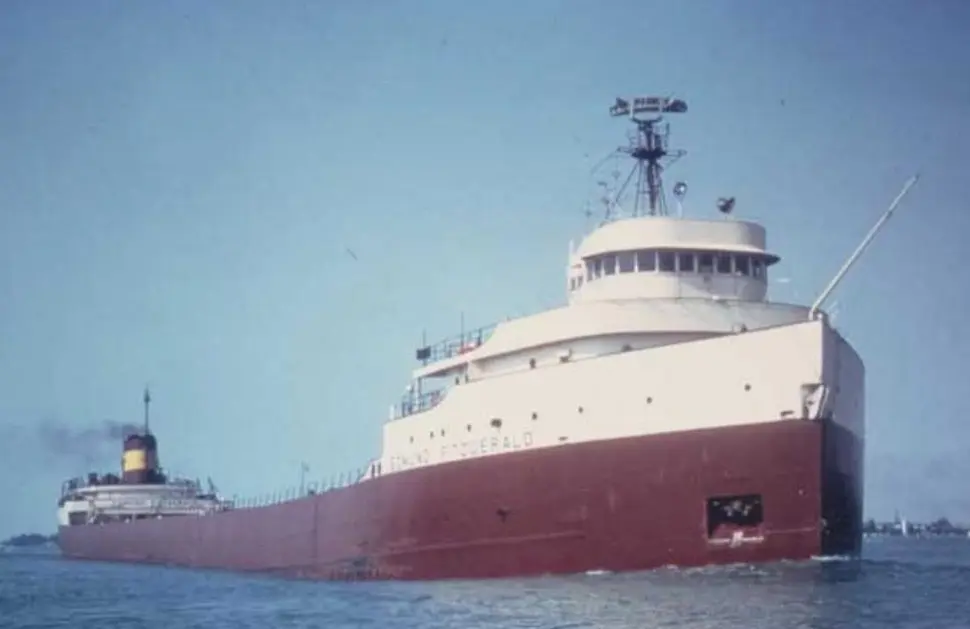Who were the men lost on Edmund Fitzgerald? Remembering the tragedy on 50th anniversary
-
 SS Edmund Fitzgerald (Image via Instagram/@michiganmanhattan)
SS Edmund Fitzgerald (Image via Instagram/@michiganmanhattan)It was 50 years ago, on November 10, 1975, when the SS Edmund Fitzgerald, a storied vessel built to be one of the largest and most powerful freighters to navigate the Great Lakes, sank in a raging storm in Lake Superior, taking all 29 crew members on board with it.
Half a century later, the tragedy still lingers in the hearts and minds of many across the Great Lakes region as one of America’s most strange disasters.
Two of The Fitz’s 29 men, engineers Russell Haskell and Oliver “Buck” Champeau, were from Sturgeon Bay, Wisconsin. Neither was a novice at sea; both men had worked for years on Great Lakes freighters.
When the 729-foot-long SS Edmund Fitzgerald sank in Lake Superior on Nov. 10, 1975, it took its entire 29-member crew with it. The men were connected to dozens of families and a number of comrades in the shipping and freight industry. We remember and honor them 50 years later.… pic.twitter.com/GjRNnlQXzt
— Detroit Free Press (@freep) November 3, 2025Oliver Champeau, a Korean War veteran who left school at 13 after his father died, had spent decades at sea before he was lost at age 41. Debbie Champeau, his daughter, was 17 when the ship went down.
"It doesn’t feel like closure at all. It feels like it’s yesterday and it brings him back and it makes me very sad... "I had no idea about anything with the Fitz. All I knew was he was going away on a ship. I just knew he’d be back, and I’d get a phone call, and it would be him, 'So I’m back in port,'" she told Fox News during the 50th anniversary remembrance.
For the families of the crew, 50th anniversary remembrance has been wrenching. Each year, friends and relatives of the lost crewmen gather at the Great Lakes Shipwreck Museum in Michigan, where a recovered bell from the Edmund Fitzgerald, brought up during what was to be the final sanctioned dive in 1995, is rung 29 times to remember those who never came home.
What we known about the SS Edmund Fitzgerald's tragic incident and its influence on several fictional stories
The Edmund Fitzgerald was on its way from Superior, Wisconsin, to Detroit carrying a load of taconite iron ore when it ran into a vicious storm about 17 miles from Whitefish Point in Michigan’s Upper Peninsula.
Waves of up to 50 feet, winds that reached gale force and freezing rain assaulted the 729-foot vessel until it disappeared from radar about 10 minutes after 7:10 p.m. local time. Moments before, the ship’s captain, Ernest McSorley had radioed another vessel by saying, “We are holding our own.” Those were his final words.
The ship now lies more than 500 feet below the surface and has been declared a gravesite by the Canadian government. The bells, lifeboats and anchor of the ship are on display at museums across Michigan as symbols of bravery and loss.
The cultural memory of the disaster lives on, too. In 1975; Gordon Lightfoot’s ballad The Wreck of the Edmund Fitzgerald forever memorialized the ship’s loss with chilling lyrics saying, “the lake that never gives up her dead.”
Today, on the 50th anniversary, bells across Michigan, Wisconsin and Ohio are ringing again 29 times to mark that loss of life. Fifty years later, the sense of loss still feels fresh for families and communities connected to the Great Lakes.
TOPICS: Edmund Fitzgerald, Gordon Lightfoot, Oliver Champeau, Russell Haskell, Great Lakes, Human Interest, Michigan, The Wreck of the Edmund Fitzgerald